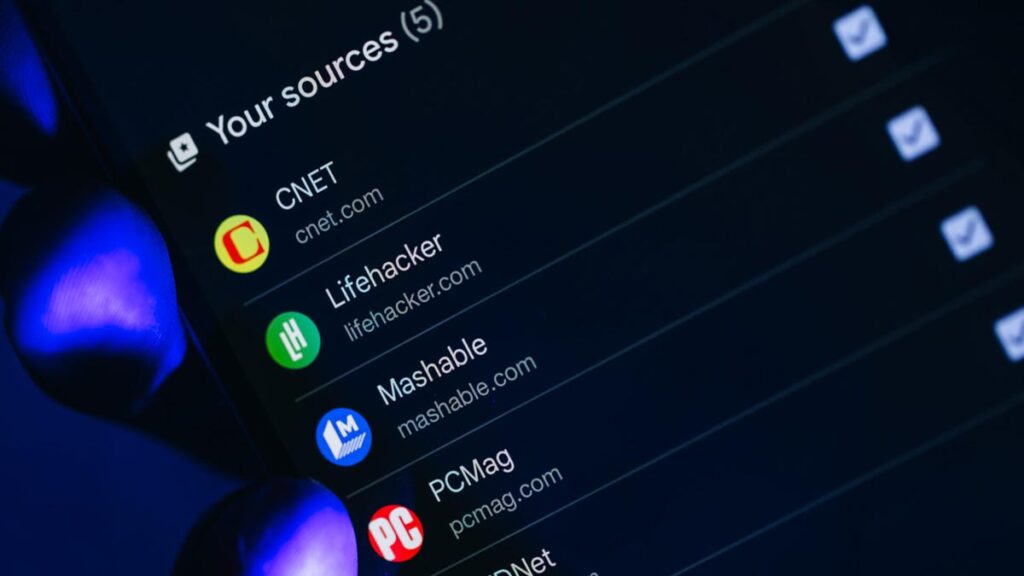Facing criticism for degraded search results and angst from users wanting to avoid AI Overviews, Google has announced a new search feature that lets you choose the sites you want to see in your news and search results.
Google said in a recent blog post that it’s launching Preferred Sources in the US and India this month. The new feature can be accessed through a plus icon to the right of Top Stories panels or a direct link to your preferences.
“Once you select your sources, they will appear more frequently in Top Stories or in a dedicated ‘From your sources’ section on the search results page. You’ll still see content from other sites, and can manage your selections at any time,” Google said.
The new feature is the result of a Labs experiment. Google says that in that version, half of its users added four or more sources. Google offered advice to website publishers and owners on how to direct readers to add their site.
How you can select your own preferred sources on Google Search
It’s simple to add preferred sources for Google Search. You can click the star icon to the right of any “Top Stories” panel in Google Search, which will spawn a pop-up window to add sources, or you can visit the settings page directly at https://www.google.com/preference/source.
Google has added a preferred sources link next to Top Stories for users in the US and India.
Once you see the search box that says “Search by name or website,” type the name or URL of a site you definitely want to include in your search results — such as CNET or its sibling tech sites ZDNET, Mashable, PCMag and Lifehacker — then select the checkbox next to each site you want to add.
To view and manage your preferred sources, click on the “Your sources” link at the bottom of the preferences page. To remove any of your preferred sources, simply uncheck the checkbox for any sites you want to delete.
It’s easy to add and remove preferred sources.
You can use any web browser on desktop or mobile to take advantage of Google’s new preferred sources feature, but you will need to be signed in to your Google account.
What it means for news sites and their readers
News organizations and other information sites have shifted before to cater to Google’s search algorithm as well as those on other platforms including Facebook and Instagram. Publishers executed a pivot to video in the 2010s, and in recent years produced more bite-sized content suitable for sharing on platforms such as TikTok.
Here’s how you get to select your news sources.
The addition of news preferences might be a double-edged sword, giving you more control over search results while further shutting out some legitimate news publishers as new echo chambers get built.
“It’s almost like a tone-deaf move by Google in my point of view, because news organizations are already concerned about losing traffic to the AI overviews,” said Alex Mahadevan, director of MediaWise at Poynter, a nonprofit, nonpartisan media literacy program. “Now they have to figure out how to get people to pick their source in the source preferences.”
For bigger news publishers who have a loyal audience, Preferred Sources might prove that audience engagement efforts can pay off. But Mahadevan says it will depend on how willing people are to effectively subscribe to and curate their own news sources list.
“I question how many people will actually use it,” he said.
People may see their own beliefs reinforced, not challenged
Publishers who haven’t cultivated engaged, loyal followers and don’t have the means to steer their audiences might suffer, Mahadevan says.
“The thing that does concern me about this is you know for the organizations that may have not done that, it’s just going to further erode the amount of Google traffic they get,” Mahadevan said. “If way more people want news from Fox News and are choosing Fox News among their source preferences, then that’s going to be crowding out other news sites that might need that traffic.”
As an experiment, Mahadevan says he set Breitbart News Network as a source using the Google Search feature, saying he chose the far-right news source because it has been known to share misinformation.
“I started Googling about tariffs, and the first thing I see is Breitbart,” he said. “So this concerns me also from a media literacy standpoint because I think it might further push people into echo chambers,” where they only see beliefs that correspond with those they already hold.
“It just seems like a way for people to narrow down their news diet even more via Google Search,” Mahadevan said.
If SEO, the way that websites have for decades drawn Google traffic by generating good, relevant content, is effectively out the window, what does that mean for the future of publishing and media?
“Is there a strong enough media literacy base for people to make sure they’re choosing good, legitimate news outlets and a varied variety of news sources?” Mahadevan asked. “I don’t know if we’re quite there yet.”

